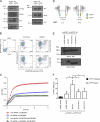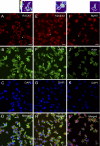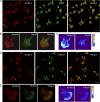Kindlin-3 mediates integrin αLβ2 outside-in signaling, and it interacts with scaffold protein receptor for activated-C kinase 1 (RACK1)
- PMID: 22334666
- PMCID: PMC3322817
- DOI: 10.1074/jbc.M111.299594
Kindlin-3 mediates integrin αLβ2 outside-in signaling, and it interacts with scaffold protein receptor for activated-C kinase 1 (RACK1)
Abstract
Integrins are heterodimeric type I membrane cell adhesion molecules that are involved in many biological processes. Integrins are bidirectional signal transducers because their cytoplasmic tails are docking sites for cytoskeletal and signaling molecules. Kindlins are cytoplasmic molecules that mediate inside-out signaling and activation of the integrins. The three kindlin paralogs in humans are kindlin-1, -2, and -3. Each of these contains a 4.1-ezrin-radixin-moesin (FERM) domain and a pleckstrin homology domain. Kindlin-3 is expressed in platelets, hematopoietic cells, and endothelial cells. Here we show that kindlin-3 is involved in integrin αLβ2 outside-in signaling. It also promotes micro-clustering of integrin αLβ2. We provide evidence that kindlin-3 interacts with the receptor for activated-C kinase 1 (RACK1), a scaffold protein that folds into a seven-blade propeller. This interaction involves the pleckstrin homology domain of kindlin-3 and blades 5-7 of RACK1. Using the SKW3 human T lymphoma cells, we show that integrin αLβ2 engagement by its ligand ICAM-1 promotes the association of kindlin-3 with RACK1. We also show that kindlin-3 co-localizes with RACK1 in polarized SKW3 cells and human T lymphoblasts. Our findings suggest that kindlin-3 plays an important role in integrin αLβ2 outside-in signaling.
Figures







Similar articles
-
A role of kindlin-3 in integrin αMβ2 outside-in signaling and the Syk-Vav1-Rac1/Cdc42 signaling axis.PLoS One. 2013;8(2):e56911. doi: 10.1371/journal.pone.0056911. Epub 2013 Feb 20. PLoS One. 2013. PMID: 23437269 Free PMC article.
-
Kindlin-3 interacts with the ribosome and regulates c-Myc expression required for proliferation of chronic myeloid leukemia cells.Sci Rep. 2015 Dec 18;5:18491. doi: 10.1038/srep18491. Sci Rep. 2015. PMID: 26677948 Free PMC article.
-
The kindlin 3 pleckstrin homology domain has an essential role in lymphocyte function-associated antigen 1 (LFA-1) integrin-mediated B cell adhesion and migration.J Biol Chem. 2013 May 24;288(21):14852-62. doi: 10.1074/jbc.M112.434621. Epub 2013 Apr 17. J Biol Chem. 2013. PMID: 23595985 Free PMC article.
-
Kindling the flame of integrin activation and function with kindlins.Curr Opin Hematol. 2009 Sep;16(5):323-8. doi: 10.1097/MOH.0b013e32832ea389. Curr Opin Hematol. 2009. PMID: 19553810 Free PMC article. Review.
-
Phosphorylation of Kindlins and the Control of Integrin Function.Cells. 2021 Apr 7;10(4):825. doi: 10.3390/cells10040825. Cells. 2021. PMID: 33916922 Free PMC article. Review.
Cited by
-
The dendritic cell cytoskeleton promotes T cell adhesion and activation by constraining ICAM-1 mobility.J Cell Biol. 2015 Feb 16;208(4):457-73. doi: 10.1083/jcb.201406120. Epub 2015 Feb 9. J Cell Biol. 2015. PMID: 25666808 Free PMC article.
-
Kindlin-3 in the immune system.Am J Clin Exp Immunol. 2014 Feb 27;3(1):37-42. eCollection 2014. Am J Clin Exp Immunol. 2014. PMID: 24660120 Free PMC article. Review.
-
Lessons from rare maladies: leukocyte adhesion deficiency syndromes.Curr Opin Hematol. 2013 Jan;20(1):16-25. doi: 10.1097/MOH.0b013e32835a0091. Curr Opin Hematol. 2013. PMID: 23207660 Free PMC article. Review.
-
Knockdown of the KINDLIN-2 Gene and Reduced Expression of Kindlin-2 Affects Vascular Permeability in Angiogenesis in a Mouse Model of Wound Healing.Med Sci Monit. 2018 Aug 2;24:5376-5383. doi: 10.12659/MSM.910059. Med Sci Monit. 2018. PMID: 30070977 Free PMC article.
-
Site-specific phosphorylation regulates the functions of kindlin-3 in a variety of cells.Life Sci Alliance. 2020 Feb 5;3(3):e201900594. doi: 10.26508/lsa.201900594. Print 2019 Mar. Life Sci Alliance. 2020. PMID: 32024667 Free PMC article.
References
Publication types
MeSH terms
Substances
LinkOut - more resources
Full Text Sources
Other Literature Sources
Molecular Biology Databases
Research Materials
Miscellaneous

